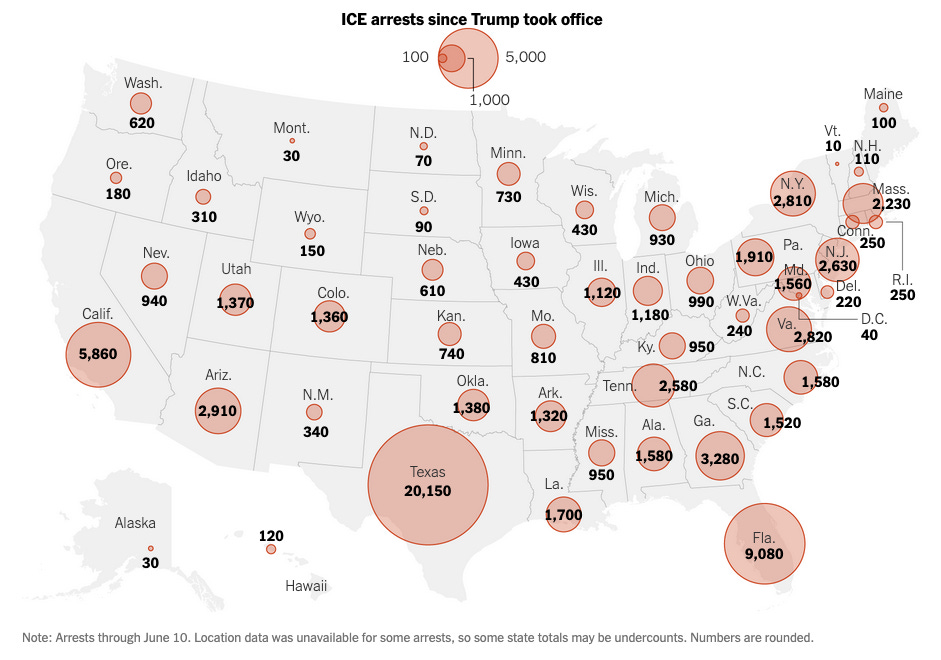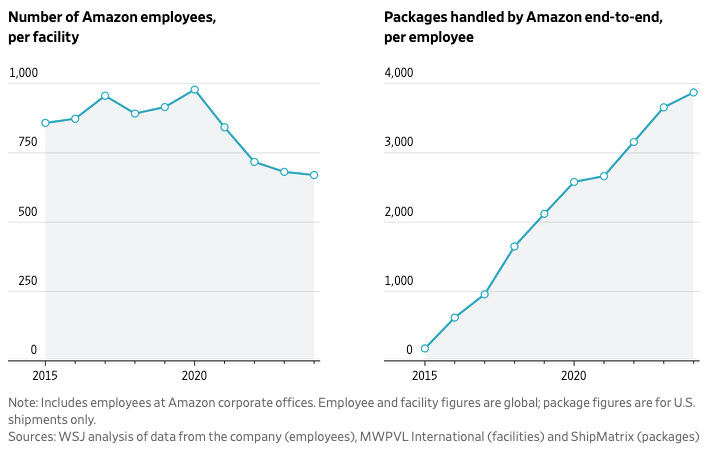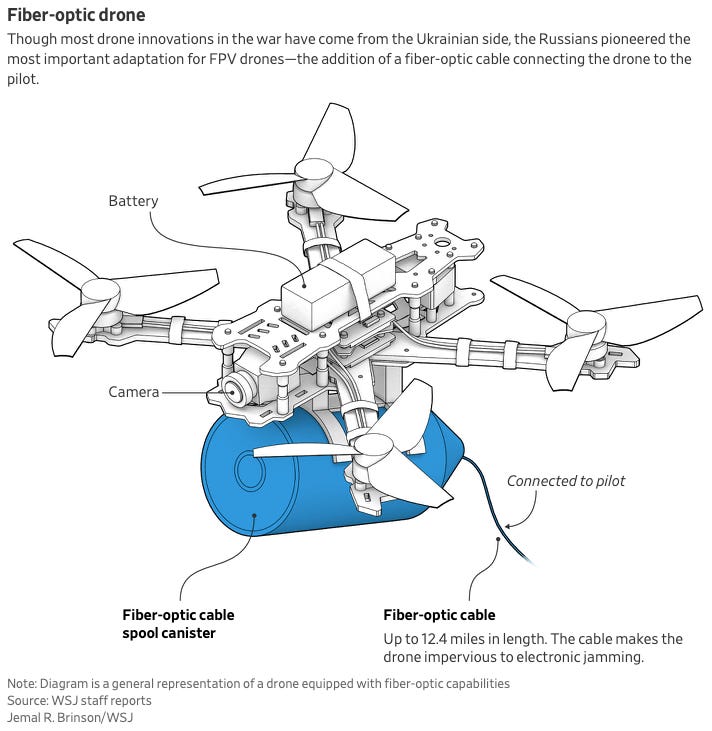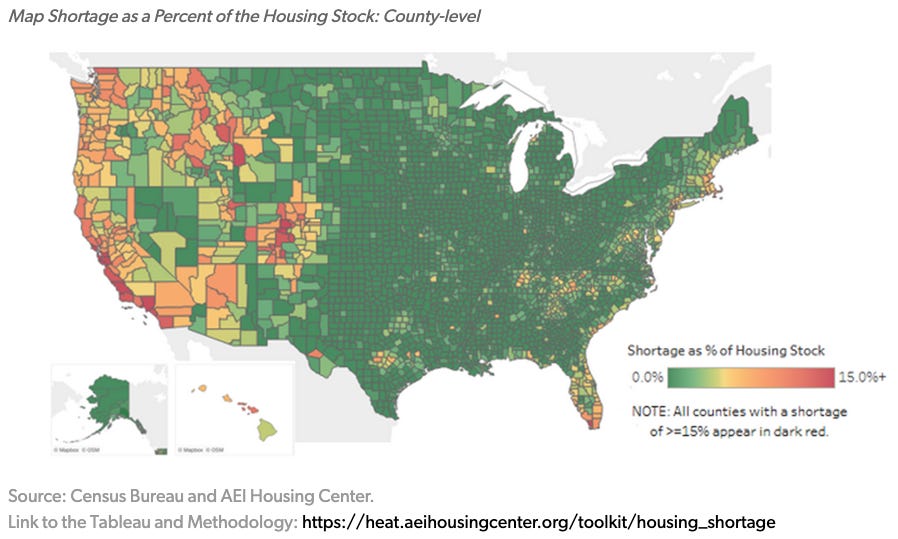11 Things from the week | 13 Jul 25
News from the past week, and a few other things.
1. China’s giant new gamble with digital IDs (Economist)
In China, national ID cards have been required since 1984 for citizens over 16 to travel, pay taxes, and access services. Now, the government is rolling out “digital IDs” for online use, transferring verification control from private companies to the state. Citizens must provide extensive personal information, including facial scans, via an app to get these IDs, which they can then use to access other apps or websites. Though currently voluntary, authorities are pressuring people to enroll, targeting China’s 1.1 billion internet users and the massive tech firms that serve them. Officially, the system aims to combat fraud and protect personal data from scammers, but critics warn it will expand government surveillance by making it easier to track individuals’ online activities and integrate them into broader monitoring systems.
2. Immigration Arrests Are Up Sharply in Every State. Here Are the Numbers. (NYT)
Immigration arrests have increased nationwide and more than doubled in 38 states in the months since President Trump took office, new data shows.

3. The US dollar is on track for its worst year in modern history (Semafor)
The US dollar is on track for its worst year in modern history and may not be done falling yet. The greenback is down more than 7% this year and Morgan Stanley predicts it could fall another 10%.
A weaker dollar could make US exports more competitive, boosting Trump’s plan to rebalance US trade, but makes imports more expensive, adding to the sting of tariffs. The year that came closest to 2025 in dollar depreciation was 1973, and the result was then-President Richard Nixon taking the US off the gold standard.
4. Amazon Is on the Cusp of Using More Robots Than Humans in Its Warehouses (WSJ)
The automation of Amazon.com facilities is approaching a new milestone: There will soon be as many robots as humans.
The e-commerce giant, which has spent years automating tasks previously done by humans in its facilities, has deployed more than one million robots in those workplaces, Amazon said. That is the most it has ever had and near the count of human workers at the facilities.
5. How Old-School Tech Is Rewiring Drone Warfare in Ukraine (WSJ)
As Russia and Ukraine battle to gain an edge on the battlefield, fiber-optic drones are a distinctly old-school response to the way both sides have used electronic warfare and physical barriers to make most ordinary craft ineffective. Instead of using radio signals that can be easily blocked, fiber-optic drones transmit data back to the pilot through the cable they unspool as they fly.
“If it wasn’t for those drones, I’m not sure what I’d be doing right now,” said a top pilot with Ukraine’s 68th Brigade’s Dovbush Hornets, which carried out the bridge ambush that killed several Russians. “Fiber optics is a lifeline.”
The rapid pace of technological innovation that has accompanied the war makes the arrival of fiber-optic drones seem like a logical development.
A shortage of artillery shells since 2023 has forced Ukraine to increasingly rely on millions of so-called first-person-view—or FPV—drones, which are equipped with a camera and a small explosive to take out enemy soldiers, weapons caches and armored vehicles.
During flight, the cable is unwound and released through a small opening in the box, ensuring an airtight connection between the device and its pilot. The drones can then be deployed at the beginning of a combined attack to disable Russian electronic-warfare systems and pave the way for squadrons of radio-guided drones to decimate the enemy position.
Russia was the first to use fiber-optic drones in the war and deployed them successfully during its offensive to retake parts of the Kursk region last fall. During the fighting, some Russian pilots idled their drones by the roadside, waiting for Ukrainian vehicles to pass by before chasing them down the road and destroying them.
Ukraine has raced to catch up with the Russians. It has started training its troops on the new technology, which it had experimented with earlier but never implemented in combat.
6. Can pizza orders predict military action? One man keeps track. (WP)
If foreign adversaries want to predict when and where the United States will launch a military campaign, they might rely on satellite imagery, intercepted communications or AI analysis. But if garden-variety subreddit conspiracy theorists want to gain such insights before news breaks, they might just follow the pizza.
Run by an anonymous software engineer, the social media account Pentagon Pizza Report tracks Google data for pizzerias around the military complex in Arlington. (The anonymous Google Maps data is aggregated from “timeline” or “location history” on phones, including visits made to establishments.) Often posting multiple times a day on X, PPR frequently singles out spikes in pizzeria activity, allowing its 200,000-plus followers to draw conclusions about what might be happening at the Pentagon. Mostly, it seems, these posts suggest little more than a busy (or slow) night at a pizzeria.
But occasionally, the tracker publishes a chart or two implying the Pentagon brass is burning the midnight oil just ahead of a military action, their offices littered with greasy boxes.
7. Can Trump end America’s $1.8trn student-debt nightmare? (Economist)
In recent years, America’s student-loan policy has come to resemble an alphabet soup. During the covid-19 pandemic, relief came from the CARES, ARPA and HEROES acts. Repayment plans ranged from the appropriately named (SAVE and PAYE) to the less so (PSLF and TEPSLF); even seasoned bureaucrats at the FSA will have struggled to keep track. As a result of these various policies, some $189bn in student debt was forgiven and more than $260bn of payments waived.
Such relief may have been welcome at the time, but America is now waking up to reality. The last of the pandemic-era forbearance ended in September 2023; defaults began to appear on credit records in the first quarter of this year. And the picture that is emerging is not pretty. Delinquencies are spiking (see chart 1). According to TransUnion, a credit-reporting bureau, some 21% of federal student-loan borrowers are in default, the most ever, up from 12% in February 2020. More difficulties may lie ahead. On May 5th President Donald Trump instructed the Treasury to resume collections from borrowers in default; by the end of the year loan forgiveness, which often occurs automatically after two decades of repayments, will once again be taxed at a federal level.
NOTE: Below is a more zoomed-out chart of the one above. As discussed in the article, student loan delinquencies are up (as are credit card and auto loan). The total debt balance is back to pre-pandemic levels.
8. Homeowners Who Gambled on Lower Rates Are Paying the Price (WSJ)
Millions of Americans bought homes in recent years with mortgage rates at 6.5% or higher, often betting they could refinance to a lower rate within a year or two. Now, with little hope of a rate cut in July after a solid jobs report on Thursday, many of these owners face the predicament of paying those higher costs for longer than they expected.
NOTE: Latest average mortgage rates from Freddie Mac:
9. America’s Six Million Home Shortage: Why California Is at the Epicenter (AEI)
A growing body of research estimates that the US faces a severe housing shortage, with missing homes numbering between 3.8 million and 8.2 million. Using the midpoint—approximately six million missing homes—new AEI Housing Center analysis shows where this shortage is most acute and why about two million missing homes can be traced back to California and its neighbors.
To pinpoint local shortages, our analysis distributed the estimated six million missing homes across counties based on each area’s median price-to-income ratio—a proven proxy for housing affordability. By applying this method, the analysis produced a national shortage estimate of 5.8 million homes across the lower 48 states.
Yet the analysis didn’t stop at a national average. It also calculated what the shortage would have been if California and ten other high-cost western states—Washington, Oregon, Idaho, Montana, Nevada, Utah, Wyoming, Colorado, Arizona, and New Mexico, which we dub the California “blast zone” states—had mirrored the housing shortages of the other 37 states (2.6 percent on average). That hypothetical baseline suggested the shortage would have been only 3.8 million homes nationally.
10. California Rolls Back Its Landmark Environmental Law (NYT)
California leaders on Monday rolled back a landmark law that was a national symbol of environmental protection before it came to be vilified as a primary reason for the state’s severe housing shortage and homelessness crisis.
For more than half a century, the law, the California Environmental Quality Act, has allowed environmentalists to slow suburban growth as well as given neighbors and disaffected parties a powerful tool to stop projects they found objectionable.
Gov. Gavin Newsom signed two bills, which were written by Democrats but had rare bipartisan support in California’s divided State Capitol, that will allow many development projects to avoid rigorous environmental review and, potentially, the delaying and cost-inflating lawsuits that have discouraged construction in the state.
11. Substack.com got more traffic than The Wall Street Journal and CBS News in June (Sherwood)
For creators looking to reach their audience directly whenever they like, and maybe even make millions in the process, Substack has been one of the places to be since its launch in 2017. Now, it’s becoming a go-to for news- and content-hungry readers, too, as US site visits hit a record 73.9 million in June, per new monthly data from Similarweb.
Last month, Substack’s site visits outweighed The Wall Street Journal and CBS News — the first time the platform has drawn more American eyeballs than both news sites in the same month, as millions more people flocked to substack.com to explore free and paid publications across business, tech, and culture, or perhaps even to look into starting their own outlets. Interestingly, traffic-tracking site Similarweb actually crowned Substack as its “Digital Winner” in January, after it notched 88% growth across its website and app last year.
For context, Similarweb told Chartr that Substack authors with their own custom domains, such as Matthew Yglesias’ “slowboring.com” aren’t included in the 73.9 million figure — meaning that the dominance of Substack and its legion of writers, podcasters, and video makers is maybe even undersold by that headline stat.
Have a great week!
The Curator











